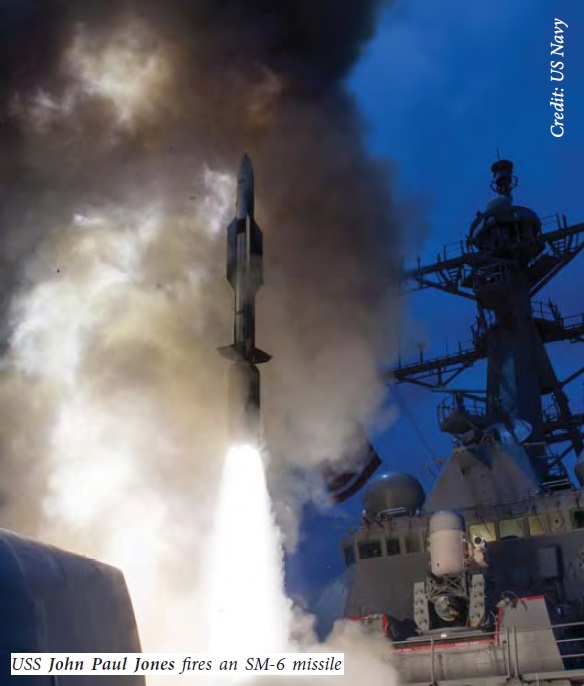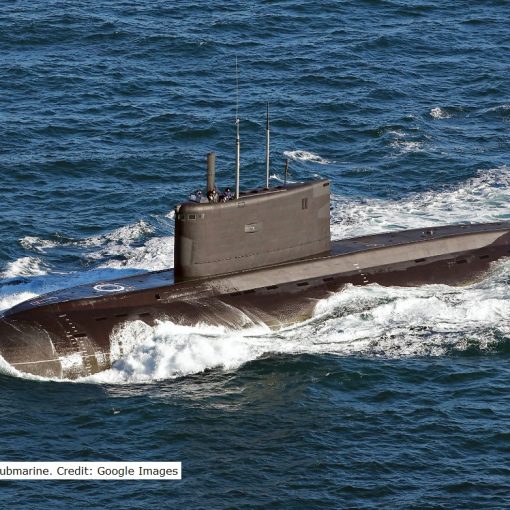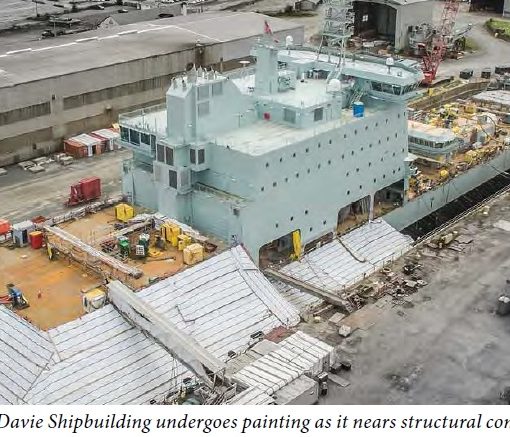30 Jan 2017. BALLISTIC MISSILE DEFENCE: DO WE NEED IT AT SEA IN THE CANADIAN SURFACE COMBATTANT?
There has been a fair amount of controversy surrounding whether or not the Canadian Surface Combatant should include a defensive capability against a ballistic missile threat. A hard kill intercept capability against this type of threat is expensive; and there are alternatives, depending on what Canada is trying to accomplish.
BALLISTIC MISSILE THREAT
Ballistic missiles can be divided into four categories based on range. Payloads include high explosive, chemical, biological and nuclear. Missiles in the short and medium range are widely held. Missiles in the intermediate and intercontinental categories tend to be part of a nuclear strategic arsenal. An emerging category is anti-ship ballistic missiles designed to put large warships at risk.
The challenge of defending against ballistic missiles is several folds. Short and medium range ballistic missiles are relatively slow and don’t venture far into the upper atmosphere. However, the longer the range of the ballistic missile, the faster the missile flies and the higher into the atmosphere and space its ventures, and the more likely it is to use decoys and multiple re-entry vehicles. To further complicate the problem, some ballistic missiles can be sea-based presenting the challenge of a wide firing azimuth with variable launch distances and the ability of the launch platform to cloak itself in the oceans
DEFENSE AGAINST THE BALLISTIC MISSILE
Ballistic missile defense encompasses a broad spectrum of capability. The United States Ground-Based Midcourse Defense system is designed to deal with the intermediate and intercontinental ballistic missile threats. Most of the tactical and theatre defensive systems designed to be used against short and medium range ballistic missiles are ground based; examples include: Patriot Advanced Capability (PAC3), the French MBDA SAMP/T with Aster 30 New Technology, Terminal High Altitude Area Defense (THAAD) and Aegis Ballistic Missile Defense (BMD) ashore. Some systems are sea based, such as the Israeli Iron Dome System and potentially French and British systems based on upgrades to the “Aster 30” family of missiles. The most sophisticated sea-based defensive systems are the USN Aegis BMD Weapon systems installed in some Ticonderoga Class (CG-47) cruisers as well as the Arleigh Burke Class (DDG 51) destroyers using: the Aegis combat system, the SPY 1 phased array radar (upgraded to a newer the Air and Missile Defense Radar (AMDR) in the DDG 51 Flight IIIs), and using Standard Missiles including: the SM2 Block 4/ SM6 (SM-6 capable of both air defense and ballistic missile defense) covering the short and medium range ballistic missile threats and the SM3 in its more sophisticated variants also able to deal with the intermediate range ballistic missile threat as well as cruise missiles.
The current generation of strategic inter-continental ballistic missile defense systems has had mixed results in tests underscoring the problems of dealing with the more sophisticated threat. Meanwhile, tactical and theatre ballistic missile defense systems have demonstrated good success dealing with the short through intermediate range ballistic missile.
The development of anti-ship ballistic missiles especially by China (DF-21 and DF-26) in an area-denial role represents a potential strategic game changer putting US Navy’s major combatants at risk in the Pacific approaches to China. The Iranians have also developed a short range anti- ship ballistic missile (Khalij Fars) capability in an area-denial role for the Straits of Hormuz.
CANADIAN OPTIONS
It is within this strategic context that Canada needs to assess its position regarding ballistic missile defense. In general, there are four approaches:
- participate in the strategic defense of North America;
- participate in the defense of NATO Europe;
- protect a defended area in a theater of operations; or
- provide Canadian warships with a self-defense capability against short-range anti-ship ballistic missiles.
The first question Canadian politicians need to answer is one of whether or not the potential of a strategic nuclear ballistic missile threat to Canada’s land mass and North America by an emergent rogue nuclear power needs to be addressed.
While it is unlikely that Canada would be purposefully targeted, it is possible that an errant missile launched against the United States would fall on Canada. Furthermore, there is no guarantee that the US Ground-Based Midcourse Defense system would be used to protect Canada, especially if there was a more immediate threat to US territory, given the small number of intercept missiles available. It should also be noted that there is no sea-based ballistic missile defense systems that can deal with the intercontinental ballistic missile threat.
In June 2014 the Canadian Standing Senate Committee on National Security and Defence recommended that the Government of Canada enter into an agreement with the United States to participate as a partner in continental ballistic missile defense. Additionally, in June 2015, the House of Commons Standing Committee on National Defence also discussed the issue of Ballistic Missile Defence in their report “Canada and the Defence of North America”. Surprisingly, this committee was silent on recommending Canadian participation.
Canada could instead join the US and its European NATO allies under the NATO ALTBMD program in providing theater ballistic defense to Europe. This NATO initiative has both land-based components and a command center. It also includes an at sea component based upon four mission dedicated Aegis BMD Arleigh Burke Class destroyers home ported in Spain.
As a consequence of this rogue nation ballistic missile defense threat to Europe, several NATO European navies are considering evolving a ballistic missile defense capability at sea including the: United Kingdom (Type 45), German (F124 Sachsen), Spanish (F100 / F105 Álvaro de Bazán) and Dutch (De Zeven Provinciën). To be clear, none of these European navies have committed to fielding active theatre ballistic missile defense systems at sea, rather some have demonstrated an ability to track ballistic missile threats and have participated in integrated air missile defense exercises with the United States either independently or as part of the Maritime Theatre Missile Defense Forum (MTMD). Canada participated in a MTMD at sea demonstration in Oct 2015 with a focus on integrating into the common data information exchange and a cruise missile engagement.
An argument can also be made for ballistic missile defense of a defended area in support of a forward theater of operations at a tactical level. Under this option, the defended area could be a key port, a population center close to the sea or an amphibious operating area. These can all be considered point targets where the capability to defend them against a short or medium range ballistic missile threat is more realizable and affordable, with several defensive systems either currently fielded or emergent either ashore or at sea e.g. PAC3, SM2/SM6.
Clearly, if Canada participated in these types of operations it would only do so as part of coalition operations, given the limited capacity of the Canadian Forces to conduct independent expeditionary operations in a geographically remote conflict area.
So what role could Canada fill in a coalition? Clearly, the more capability one brings to the operation the larger the potential for a leadership role and hence greater influence. When the Canadian Navy speaks of the requirement to have an area air defense destroyer capable of defending a force or operating area from fighter / bomber, cruise and ballistic missile threat it is also calling for a command and control capability from which to command operations and directly provide Canadian influence to the operation and indirectly to the various military and political fora directing the campaign.
An at sea ballistic missile defense capability is expensive. There is not only the cost of the sensor suite to detect, the weapon system to launch and engage the threat, and the ship platform on which it is carried. There is also the requirement to connect into local, theater and potentially strategic command, control, battle management and communications systems (C2BMC), missile inventories, and continuing research and development and the evolution of the systems since the capability is still relatively new and evolving. For example, the cost of constructing a DDG 51 flight 3 destroyer is $USD 2B and this does not include spares, program management, lifecycle management and weapon inventories. There is also a cost differential in the type of interceptor. One report puts the cost of a single SM 6 missile at $USD 4M compared with a single SM 3 missile at $USD 10M.
Costs of other NATO navies Command and Control Area Air Defense warship classes with the possibility of some future ballistic missile defense capability are also expensive; for example, the UK Type 45 (commissioned starting 2009) cost 1.1 B pounds sterling each, the Spanish F105 (commissioned in 2012) cost 834 million euros, the German Type F124 (commissioned starting 2004) 700 million euros each, and the Dutch De Zeven Provinciën (commissioned starting in 2002) 600 million euros. Costs to evolve these platforms to an anti-ballistic missile capability would be additive.
CONCLUSION
Ballistic Missile Defense is first and foremost about defending people and military forces ashore. The emergent development of anti-ship ballistic missiles is a valid concern but is a secondary consideration.
If the greatest risk to Canada is deemed to be from rogue nuclear states either targeting Canada or the United State then some level of participation in the US Ground-Based Midcourse Defense system makes the most sense: it builds on work already done by the United States; allows for burden sharing; provides for commonality of systems, and demonstrates common resolve and commitment to the defense of North America.
If our political leaders deem there to be a limited ballistic missile threat to Canada and there continues to be in the Canadian zeitgeist a disinclination to defend North America in partnership with the United States from the ballistic missile threat, then there could be a role for the Canadian Navy to participate in the defense of NATO Europe by joining the ALTBMD programme either ashore or at sea. In my opinion, NATO European countries should be the first to step up to this task either through the funding of ground-based systems or the evolution of their naval systems to a theater anti-ballistic missile defense capability. Canada could provide some cost burden sharing as a demonstration of NATO solidarity.
Should Canada aspire to the command and control of a limited defended operating area from the sea then some capability against short and medium range ballistic missiles may be required. This capability can either be of a limited nature, such as acquiring radar sensors capable of detecting ballistic missiles and data exchange systems capable of participating in a coalition battle management network as part of an integrated air missile defense system, or more comprehensively by actually acquiring the capability to intercept ballistic missiles using some variant of the Aegis BMD weapon system and the SM2 / SM6 missile, or some evolved NATO variant if they are developed.
The development of anti-ship ballistic missiles, especially by the Chinese, is just the latest in the offense/defensive spiral cycle of warfare at sea. Warships have always been and will continue to be at risk when committed to a conflict.
The Canadian government needs to decide where the greatest threat to Canadians lie whether it be: from rogue nuclear nations to the Canadian landmass; to the landmasses of NATO and coalition partners; to allies, Canadian troops and warships conducting forward operations; or the survival of Canadian warships, and respond appropriately. Whatever the decision it needs to weigh the threat of ballistic missiles against the survivability of its military forces when it decides to commit forces to operations.
Cal Mofford





One thought on “Ballistic Missile Defence – Canada’s Options by Cal Mofford”
Canada’s Commitment to Ballistic Missile Defence.
I Believe that we must get into this missile defence system, seeing as Russia is building up its military bases and other military sites throughout the Arctic regions. As we are a strong member of NATO/NORAD then we must honour our Commitment to this Missile defence system in some way shape or form. We cannot just sit here and hope that the US will protect us should this Rogue Nation Russia decide to attack the US by over flying Canada? Yes it is a very expensive step but then again Freedom has a very high price tag?? YOU WANT PEACE THEN PREPARE FOR WAR??
Thanks
Roderick